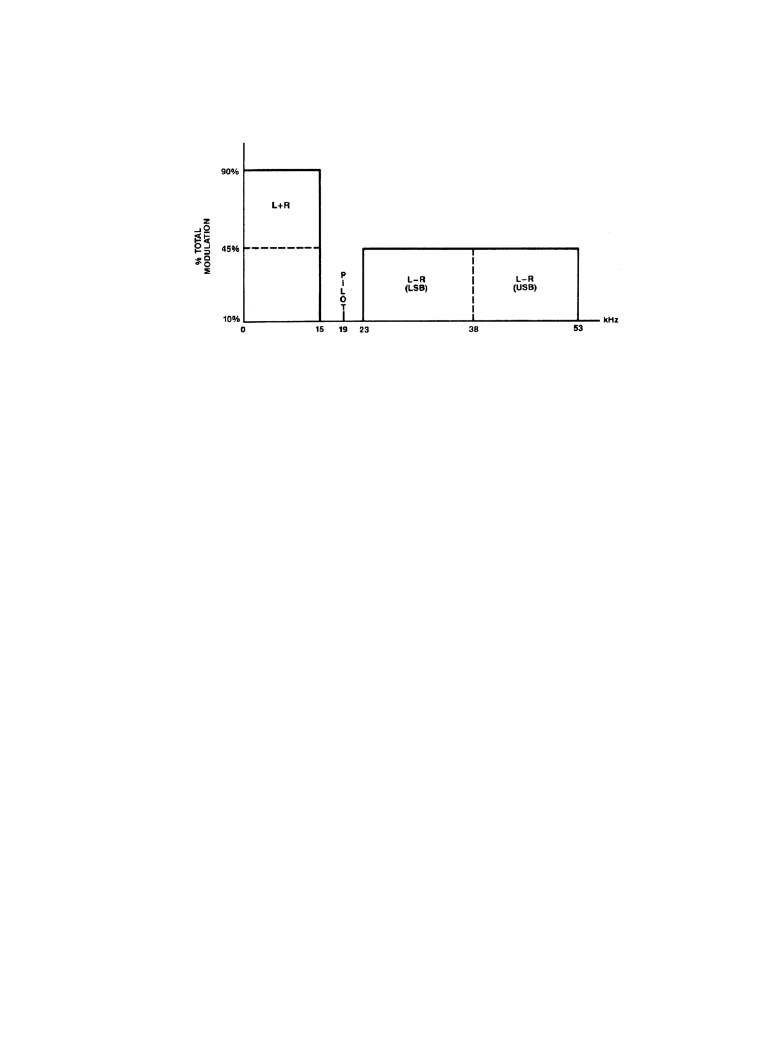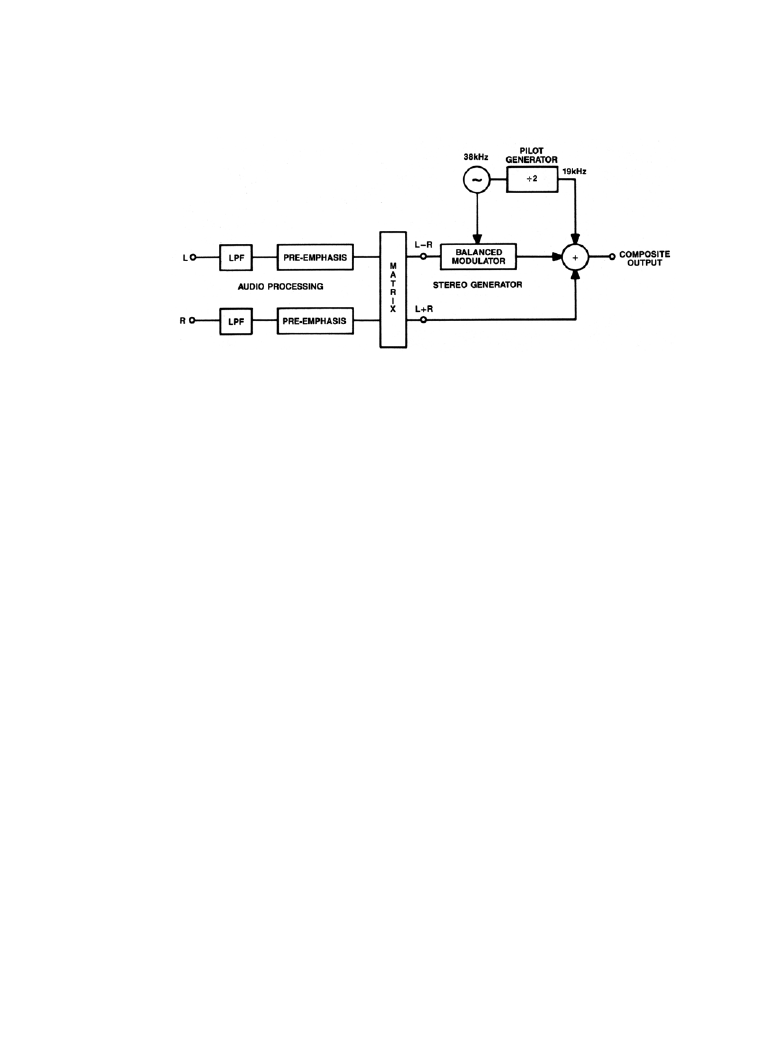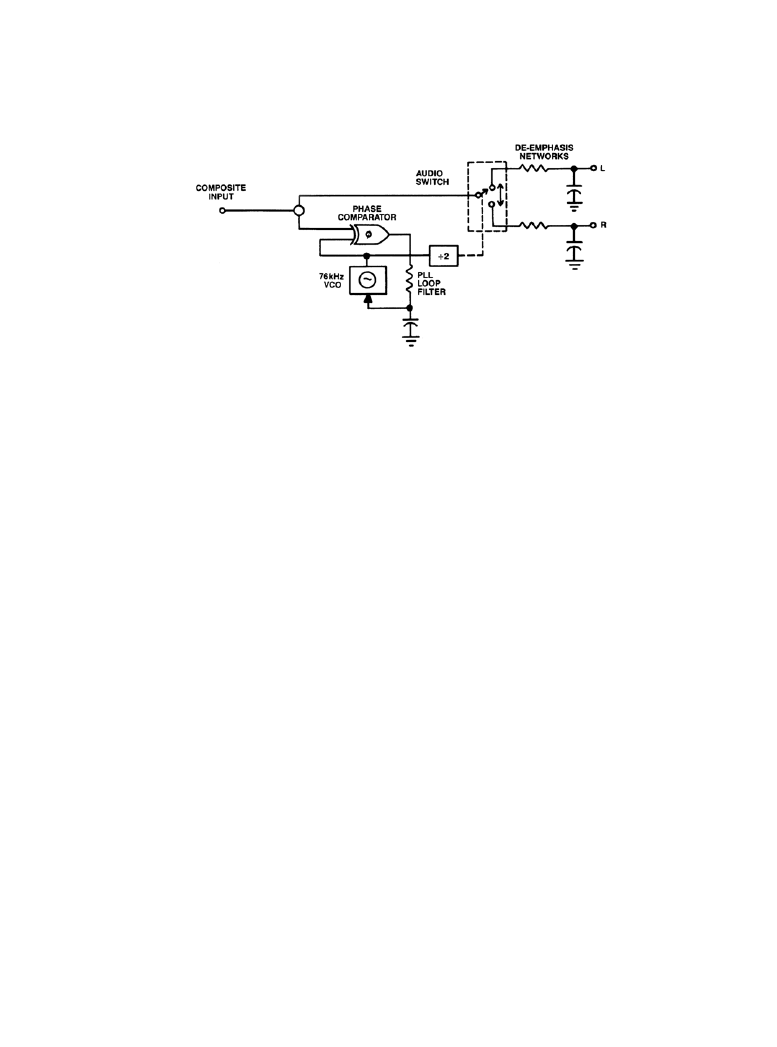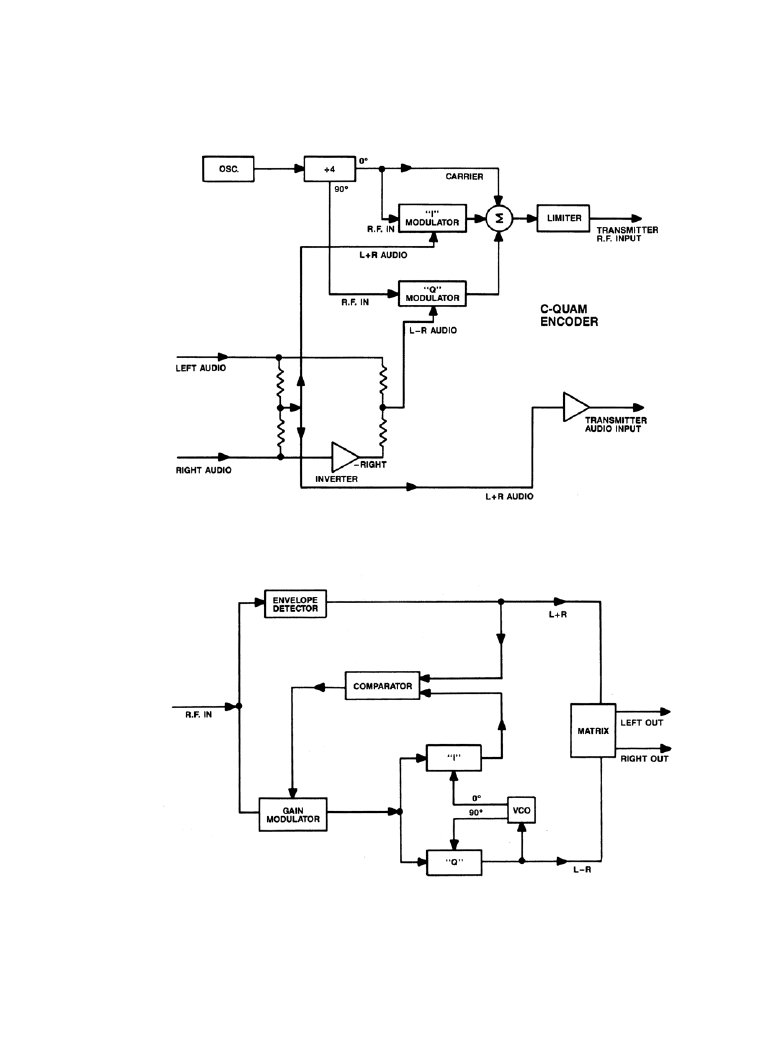ВУЗ: Казахская Национальная Академия Искусств им. Т. Жургенова
Категория: Книга
Дисциплина: Не указана
Добавлен: 03.02.2019
Просмотров: 21603
Скачиваний: 19

12-68 Radio Receivers
12.3.4 Stereo Systems
Stereophonic broadcasting has reshaped the radio industry. Stereo FM, introduced during the
early 1960s, gave FM broadcasters a powerful new marketing tool. Receiver manufacturers
responded with new radios that offered high-quality performance at an affordable price.
Although few people outside the broadcast industry know it, AM broadcasters had been talk-
ing about stereo operation as long as FM engineers. It was not until the early 1980s, however,
before AM stereo broadcasting became a reality.
12.3.4a
FM Stereo
The system devised for broadcasting stereo audio over FM has served the industry well. Key
requirements for the scheme were: 1) compatibility with monophonic receivers that existed at the
time the standard was developed, and 2) a robust signal that would not be degraded significantly
by multipath. Figure 12.3.28 shows the composite baseband that modulates the FM carrier for
stereophonic broadcasting. The two-channel baseband has a bandwidth of 53 kHz and is made
up of:
•
A main channel (L + R) signal, which consists of the sum of left plus right audio signals (the
same signal broadcast by a monaural station). A fully modulated main channel will modulate
the FM transmitter to 45 percent when broadcasting stereo programming.
•
A stereophonic subchannel (L – R), which consists of a double-sideband AM modulated car-
rier with a 38-kHz center frequency. The modulating signal is equal to the difference of the
left and right audio inputs. The subcarrier is suppressed to conserve modulation capability. As
a result, the AM sidebands have the same modulation potential as the main channel. A fully
modulated subchannel will modulate the FM transmitter to 45 percent when broadcasting ste-
reo programming.
•
A 19-kHz subcarrier pilot, which is one-half the frequency of the stereophonic subcarrier and
in phase with it. The pilot supplies the reference signal needed by stereo receivers to reinsert
the 38-kHz carrier for demodulation of the double-sideband suppressed carrier transmission.
The pilot, in other words, is used to synchronize the decoder circuitry in the receiver to the
Figure 12.3.28
The composite baseband signal of the FM stereo system.
Downloaded from Digital Engineering Library @ McGraw-Hill (www.digitalengineeringlibrary.com)
Copyright © 2004 The McGraw-Hill Companies. All rights reserved.
Any use is subject to the Terms of Use as given at the website.
AM and FM Receivers

AM and FM Receivers 12-69
stereo generator at the transmitter. The frequency tolerance of the pilot is ±2 Hz. The pilot
modulates the transmitter 8 to 10 percent.
Generating the Stereo Signal
Two basic approaches have been used to generate the stereophonic subchannel: time-division
multiplexing (TDM), the switching method; and frequency-division multiplexing (FDM), the
matrix method.
A simplified block diagram of the FDM approach is shown in Figure 12.3.29. The left and
right audio channels first pass through a preemphasis circuit and low-pass filter. They are then
supplied to the matrix, which produces sum and difference components. The audio signals are
added to form the L + R main channel signal.
The difference signal is fed to a balanced modulator that generates the L – R subchannel.
Because a balanced modulator is used, the 38-kHz carrier is suppressed, leaving only the modu-
lated sidebands. The 19-kHz pilot signal is derived by dividing the 38-kHz oscillator by 2. The
main channel, stereophonic sub-channel, and pilot are then combined in the proper (45/45/10
percent) ratio to form the composite baseband.
The TDM method of generating a stereo signal is shown in block diagram form in Figure
12.3.30. The L + R and L – R signals are generated by an electronic switch that is toggled at a
38-kHz rate. The switch samples one audio channel and then the other. Considerable harmonic
energy is generated in this process, requiring the use of a low-pass filter. When the harmonics are
filtered out, the proper composite waveform results. This approach, while simple and stable, may
produce unwanted artifacts, most notably reduced stereo separation, because of the filtering
requirements.
An improvement to the basic TDM concept is shown in Figure 12.3.31. By using a soft switch
to sample the left and right channels, it is possible to eliminate the low-pass filter and its side-
effects. The variable element shown in the figure consists of an electronic attenuator that is capa-
ble of swinging between its minimum and maximum attenuation values at a 38-kHz rate. Like
the fast-switching TDM system, the L + R and L – R channels are generated in one operation. No
Figure 12.3.29
Functional block diagram of a frequency-division multiplexing (FDM) FM stereo
generator.
Downloaded from Digital Engineering Library @ McGraw-Hill (www.digitalengineeringlibrary.com)
Copyright © 2004 The McGraw-Hill Companies. All rights reserved.
Any use is subject to the Terms of Use as given at the website.
AM and FM Receivers

12-70 Radio Receivers
filter is required at the output of the generator as long as the 38-kHz sine wave is free from har-
monics and the variable attenuator has good linearity.
Decoding the Stereo Signal
All stereo FM receivers include a circuit to convert the multiplexed signal at the FM detector to
the left and right audio channels originally transmitted by the station. There are a number of
ways to accomplish this task. In practice, however, one type of decoder is most commonly found,
built around a PLL integrated circuit (see Figure 12.3.32). This system offers both high perfor-
mance and low cost.
The composite signal from the demodulator is fed to a buffer amplifier and sampled by a PLL
within the decoder IC. A voltage controlled oscillator, typically running at 76 kHz (four times
the pilot frequency) is locked in phase with the pilot by the error output voltage of the PLL. The
oscillator signal is divided by 2, resulting in a square wave at 38 kHz with nearly perfect duty
cycle and fast rise and fall times. This signal drives the audio switcher (demultiplexer) to transfer
Figure 3.30
Functional block diagram of a time-division multiplexing (TDM) FM stereo generator.
Figure 3.31
Functional block diagram of a time-division multiplexing stereo generator using a vari-
able electronic attenuator.
Downloaded from Digital Engineering Library @ McGraw-Hill (www.digitalengineeringlibrary.com)
Copyright © 2004 The McGraw-Hill Companies. All rights reserved.
Any use is subject to the Terms of Use as given at the website.
AM and FM Receivers

AM and FM Receivers 12-71
the composite baseband to the left and right audio outputs in synchronization with the station’s
stereo generator. A deemphasis circuit follows the matrix to complement the signal preemphasis
at the FM transmitter.
12.3.4b
AM Stereo
AM stereo operation was approved by the FCC in 1981 using the C-QUAM (Motorola) system.
A modification of simple quadrature modulation, C-QUAM was designed to maintain monopho-
nic compatibility.
The C-QUAM encoder is shown in Figure 12.3.33. As in FM stereo broadcasting, sum and
difference signals of the left and right audio inputs are produced. Pure quadrature is generated by
taking the L + R and L – R signals and modulating two balanced modulators fed with RF signals
that are out of phase by 90° (producing components referred to as I and Q). As shown in the fig-
ure, the 90° phase shift is derived by using a Johnson counter, which divides an input frequency
(4 times the station carrier frequency) by 4 and provides digital signals precisely 90° out of phase
for the balanced modulators. The carrier is inserted directly from the Johnson counter. At the
output of the summing network, the result is a pure quadrature AM stereo signal. From there it is
passed through a limiter that strips the incompatible AM components from the signal. The output
of the limiter is amplified and sent to the transmitter in place of the crystal oscillator.
The left and right audio signals are summed and sent as compatible L + R to the audio input
terminals of the transmitter.
Decoding the C-QUAM Signal
C-QUAM AM stereo is decoded by converting the demodulated AM broadcast waveform (which
is already close to a quadrature signal) to pure quadrature and then using a quadrature detector to
extract the L – R component (see Figure 12.3.34). In order to prepare the received signal for the
quadrature demodulator, it has to be converted from the envelope-detector-compatible signal that
is broadcast to the original quadrature signal that was not envelope detector compatible. This is
accomplished by demodulating the broadcast signal in two ways: with an envelope detector and
Figure 12.3.32
Block diagram of a stereo decoder using PLL-controlled time-division multiplexing.
Downloaded from Digital Engineering Library @ McGraw-Hill (www.digitalengineeringlibrary.com)
Copyright © 2004 The McGraw-Hill Companies. All rights reserved.
Any use is subject to the Terms of Use as given at the website.
AM and FM Receivers

12-72 Radio Receivers
Figure 12.3.33
Block diagram of a C-QUAM AM stereo exciter.
Figure 12.3.34
Block diagram of a C-QUAM AM stereo decoder.
Downloaded from Digital Engineering Library @ McGraw-Hill (www.digitalengineeringlibrary.com)
Copyright © 2004 The McGraw-Hill Companies. All rights reserved.
Any use is subject to the Terms of Use as given at the website.
AM and FM Receivers